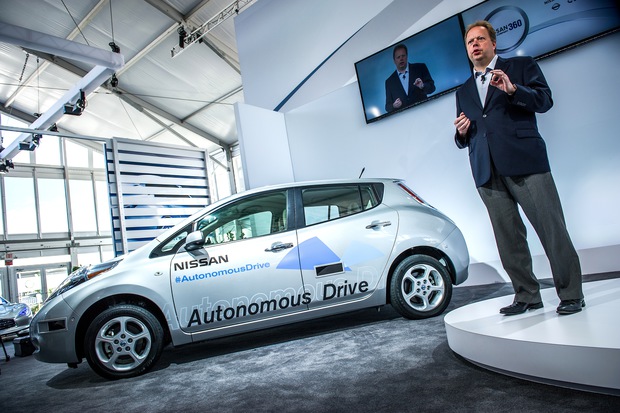History of Nissan's autonomous vehicle plans
By:
+David Herron; Date: 2021-01-03T23:53:23.601Z
Tags: Autonomous Vehicles »»»» Robocars »»»» Nissan
The process of Nissan getting to do autonomous vehicles.
Nissan Shows Fully Autonomous Cars It Plans To Build By 2020 (Sep 9, 2013): A write-up of a video shown by Nissan at the 2013 instance of Nissan 360.
At the Nissan 360 event in Southern California, executive vice president Andy Palmer said "zero emissions" and "zero fatalities" will be the twin pillars of Nissan's future product strategy.
Nissan says the car can do everything a human driver can, including changing lanes and avoiding collisions.
Palmer said that Nissan won't rely on connectivity to orient its cars. Instead, the prototypes have laser scanners and cameras for eyes, and a computer system that can "learn" new roads.
In other words this will not rely on connected vehicles with car-2-car, vehicle-2-vehicle, or vehicle-2-infrastructure communications. Tests of vehicle-to-vehicle (V2V) and vehicle-to-infrastructure (V2I) communications are now being conducted in the U.S., Europe, and Asia, using prototype technology that carmakers hope to agree on within a few years.

Nissan Promises to Deliver Autonomous Car by 2020 (Aug 27, 2013): Nissan is getting serious about self-driving cars, and is planning to deliver the first commercially-viable self-driving system by 2020. Several Nissan models are to come with Autonomous Drive technology. "In 2007 I pledged that -- by 2010 -- Nissan would mass market a zero-emission vehicle," Nissan CEO Carlos Ghosn said. "Today, the Nissan LEAF is the best-selling electric vehicle in history. Now I am committing to be ready to introduce a new ground-breaking technology, Autonomous Drive, by 2020, and we are on track to realize it."
NISSAN ANNOUNCES UNPRECEDENTED AUTONOMOUS DRIVE BENCHMARKS (Aug 27, 2013): Press release by Nissan describing their plans for autonomous driving. The first step is to construct a proving grounds, that will be an artificially created townscape in which to test autonomous driving scenarios. The autonomous driving technology is described as an extension of their "Safety Shield" which monitors a 360 degree circle for safety risks.
Nissan's autonomous driving technology is an extension of its Safety Shield, which monitors a 360-degree view around a vehicle for risks, offers warnings to the driver and takes action if necessary. It is based on the philosophy that everything required should be on board the vehicle, rather than relying on detailed external data. The technology being demonstrated at Nissan 360 means the car could drive autonomously on a highway - sticking to or changing lanes and avoiding collisions - without a map. It can also be integrated with a standard in-car navigation system so the vehicle knows which turns to take to reach its destination.
A revolutionary concept like autonomous drive will have implications throughout the design and construction of cars. For example, collision-avoidance by machines with the capability to react more rapidly and with more complex movements than a human driver will place new demands on the chassis and traction control. Nissan is leveraging 80 years of research and development expertise to create a complete solution for autonomous drive.
